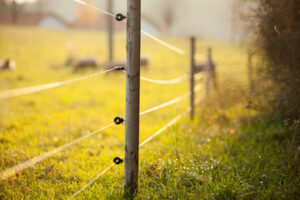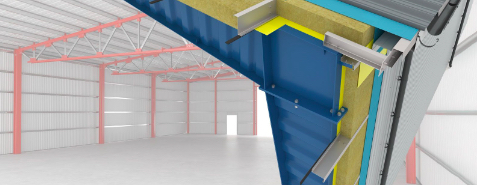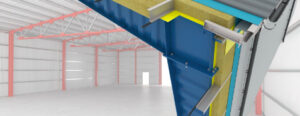Electric fences are a type of fence that uses an electric current to deter animals from approaching or crossing the fence. They are commonly used to contain livestock, such as cows, horses, and sheep, but they can also be used to protect crops, gardens, and property from wild animals and trespassers.
R.C Fence LLC works by delivering a short, sharp shock to any animal that touches the fence. The shock is not harmful, but it is unpleasant enough to deter the animal from touching the fence again. Electric fences are a safe and effective way to control animals, and they can be used to create a secure barrier around any area.

ffence
There are two main types of electric fences: permanent and portable. Permanent electric fences are designed to be installed in one place and left there for many years. They are typically made with high-quality materials, such as high-tensile wire and metal posts. Portable electric fences are designed to be moved and reinstalled easily. They are typically made with lighter materials, such as plastic posts and insulated wire.
An electric fence system consists of the following components:
- Fence charger: The fence charger is the device that provides the electric current to the fence. Fence chargers come in a variety of sizes and voltages, depending on the length and type of fence.
- Fence wire: The fence wire is the conductor that carries the electric current. Fence wire can be made from a variety of materials, including steel, aluminum, and copper.
- Insulators: Insulators are used to attach the fence wire to the posts without grounding the fence. Insulators come in a variety of shapes and sizes, depending on the type of fence post and wire being used.
- Ground rods: Ground rods are used to ground the electric fence system. Grounding the fence system helps to ensure that the shock is delivered to the animal, rather than to the person or object touching the fence.
To install an electric fence, you will need the following tools and materials:
- Fence charger: Choose a fence charger that is the appropriate size and voltage for your fence.
- Fence wire: The amount of fence wire you will need will depend on the length of your fence.
- Insulators: Choose insulators that are compatible with the type of fence post and wire you are using.
- Ground rods: Use at least two ground rods, and space them at least 10 feet apart.
- Tools: You will also need a wire cutter, a post driver, and a hammer.
Once you have gathered your tools and materials, you can begin installing the fence:
- Install the fence posts. The posts should be spaced evenly, and they should be driven into the ground at least 24 inches deep.
- Attach the insulators to the fence posts. The insulators should be spaced evenly, and they should be placed at a height that is appropriate for the type of animal you are trying to contain.
- Attach the fence wire to the insulators. Be sure to leave enough slack in the wire so that it can expand and contract with temperature changes.
- Ground the electric fence system. Use at least two ground rods, and space them at least 10 feet apart. Connect the ground rods to the fence charger with a ground wire.
- Connect the fence charger to the electric fence.
- Test the electric fence system. Use a voltage tester to make sure that the fence is delivering the correct amount of voltage.
Electric fences are safe when used properly, but it is important to take precautions to avoid accidents. Here are some safety tips for electric fences:
- Always disconnect the fence charger before working on the fence.
- Be careful not to touch the fence wire and the ground at the same time.
- Use caution when working around the fence with children and pets.
- Post warning signs around the fence to alert people and animals of the electric current.
Electric fences can be used for a variety of purposes, including:
- Containing livestock: Electric fences are commonly used to contain livestock, such as cows, horses, and sheep. Electric fences are a safe and effective way to keep livestock from wandering off or getting into crops.
- Protecting crops and gardens: Electric fences can be used to protect crops and gardens from wild animals, such as deer, rabbits, and raccoons. Electric fences can also be used to keep pets out of gardens.
- Securing property: Electric fences can be used to secure property from trespassers. Electric fences can be used to create a perimeter around a home, business, or other property.
Safety: Electric fences are a safe way to control animals. The shock that the fence delivers is not harmful, but it is unpleasant enough to deter the animal from touching the fence again.
- Cost-effectiveness: Electric fences are relatively inexpensive to install and maintain.
- Flexibility: Electric fences can be used to create a variety of fence configurations, including permanent and portable fences.
- Durability: Electric fences are durable and can withstand harsh weather conditions.
Despite their many benefits, electric fences do have a few drawbacks:
- Maintenance: Electric fences require regular maintenance to ensure that they are working properly. This includes checking the fence for breaks and making sure that the insulators are in good condition.
- Visibility: Electric fences are often less visible than traditional fences, which can increase the risk of accidents.
- Cost: The cost of installing an electric fence can vary depending on the length and type of fence, but it is generally more expensive than installing a traditional fence.
Overall, electric fences are a safe, effective, and cost-effective way to control animals and secure property. They are particularly well-suited for use in agricultural settings and large areas of land.
Here is some additional information about electric fences:
- Voltage: Electric fences typically deliver a voltage of 5,000 to 10,000 volts. The voltage is high enough to deter animals from touching the fence, but it is not high enough to be harmful.
- Pulse rate: Electric fences deliver the voltage in a series of pulses. The pulse rate is typically 1 to 2 pulses per second. The pulse rate helps to prevent the animal from becoming desensitized to the shock.
- Grounding: Electric fences must be properly grounded in order to be effective. The grounding system helps to ensure that the shock is delivered to the animal, rather than to the person or object touching the fence.
- Safety precautions: It is important to take precautions to avoid accidents when working around electric fences. Always disconnect the fence charger before working on the fence, and be careful not to touch the fence wire and the ground at the same time.
When choosing an electric fence system, there are a few factors to consider:
- Type of fence: The type of fence you need will depend on the purpose of the fence. If you are containing livestock, you will need a permanent electric fence. If you are protecting crops or gardens, you may want to consider a portable electric fence.
- Length of fence: The length of the fence will determine the size and power of the fence charger you need.
- Type of animals: The type of animals you are trying to contain will also determine the voltage and pulse rate of the fence charger you need.
- Budget: Electric fence systems can range in price from a few hundred dollars to several thousand dollars. It is important to set a budget before you start shopping.
Once you have considered all of these factors, you can start shopping for an electric fence system. Be sure to read reviews of different products before you make a purchase.
Installing and maintaining an electric fence is relatively straightforward. However, it is important to follow the instructions carefully to ensure that the fence is installed and maintained properly.
Here are some tips for installing and maintaining an electric fence:
- Installation: When installing an electric fence, be sure to follow the instructions that come with the fence charger. Be sure to properly ground the fence system, and use caution when working around the fence with children and pets.
- Maintenance: Electric fences require regular maintenance to ensure that they are working properly. This includes checking the fence for breaks and making sure that the insulators are in good condition. You should also test the voltage of the fence regularly to make sure that it is delivering the correct amount of voltage.
Electric fences are a safe, effective, and cost-effective way to control animals and secure property. They are particularly well-suited for use in agricultural settings and large areas of land.
If you are considering installing an electric fence, be sure to do your research and choose a system that is right for your needs. Be sure to follow the instructions carefully when installing and maintaining the fence system.




 Steel structures can be used to build various buildings, including warehouses, churches, storage centers, and even office spaces. They can also span longer distances, making them an excellent option for larger structures. Steel building frames can be designed to meet local area codes and load limits, which helps ensure that your new structure will be safe and up to code.
Steel structures can be used to build various buildings, including warehouses, churches, storage centers, and even office spaces. They can also span longer distances, making them an excellent option for larger structures. Steel building frames can be designed to meet local area codes and load limits, which helps ensure that your new structure will be safe and up to code.